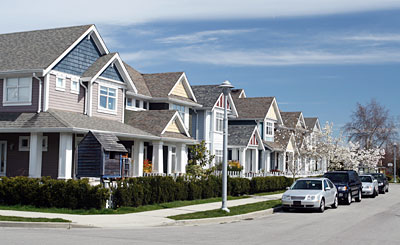Curbs and Gutters
Curbs and Drainage
Advantages | Types | Requirements | Design | AASHTO Standards | Joints | Drainage | Materials | Construction
For combined curb and gutter sections, the aprons (the portions between pavements and the faces of the curbs) should have adequate hydraulic capacity to carry runoff from most rainstorms. Making aprons wider reduces the opportunity for rainwater to move down through joints between curbs and pavements. Wider aprons may also discourage drivers from driving close to curbs.
 Since one important function of curbs is to collect runoff, provisions must be made periodically to drain water away before the roadways are flooded. In areas where there are storm sewers, the flow in gutters is diverted through inlets built into the curbs and/or gutters. In semi-arid regions where rains are infrequent, inlets are sometimes only gaps in curbs through which water can exit. In most other places, inlets are fitted with iron castings designed to match the shapes of the curbs (another good reason for using standard shapes), and with grates that extend one or two feet into the gutters. The spacing of inlets depends on the amounts of water that must be handled, and are calculated to avoid flooding of streets or roadways except on infrequent occasions, such as once every ten or twenty years. While inlet locations must be governed by rainfall and pavement elevations, designers should consider their effects on curb jointing. Inlets, which are more or less anchored in place, should be isolated from curbs and gutters.
Since one important function of curbs is to collect runoff, provisions must be made periodically to drain water away before the roadways are flooded. In areas where there are storm sewers, the flow in gutters is diverted through inlets built into the curbs and/or gutters. In semi-arid regions where rains are infrequent, inlets are sometimes only gaps in curbs through which water can exit. In most other places, inlets are fitted with iron castings designed to match the shapes of the curbs (another good reason for using standard shapes), and with grates that extend one or two feet into the gutters. The spacing of inlets depends on the amounts of water that must be handled, and are calculated to avoid flooding of streets or roadways except on infrequent occasions, such as once every ten or twenty years. While inlet locations must be governed by rainfall and pavement elevations, designers should consider their effects on curb jointing. Inlets, which are more or less anchored in place, should be isolated from curbs and gutters.
Because the sides of streets adjacent to curbs are often used by bicyclists, it is important that grates in the aprons of curbs have openings that will not be safety hazards to bicycle wheels. Grates are available that allow for the safe passage of bicycles.


